Malchion, a Church Father and presbyter of Antioch during the reigns of Emperors Claudius II and Aurelian, was a well-known rhetorician most notable for his key role in the 272 AD deposition of the heretical bishop of Antioch, Paul of Samosata. He was very familiar with and frequently quoted pagan authors. [1] and was president of the faculty of rhetoric while presbyter of Antioch. [2] He forced Paul to reveal his beliefs and wrote a letter calling him a heretic and criminal to the bishops of Rome and Alexandria. St. Jerome, a Great Western Doctor of the Catholic Church, dedicates chapter 71 of his biographical tome On Illustrious Men to Malchion. [3]
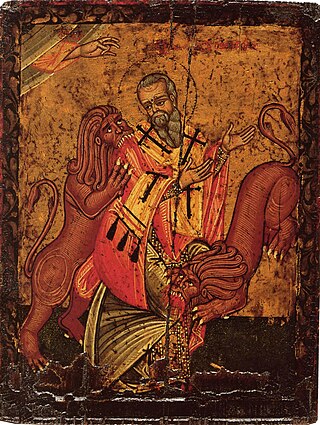
The word catholic comes from the Greek phrase καθόλου 'on the whole, according to the whole, in general', and is a combination of the Greek words κατά 'about' and ὅλος 'whole'. The first known use of "Catholic" was by the church father Saint Ignatius of Antioch in his Letter to the Smyrnaeans. In the context of Christian ecclesiology, it has a rich history and several usages.

The First Council of Nicaea was a council of Christian bishops convened in the Bithynian city of Nicaea by the Roman Emperor Constantine I in AD 325.

Ignatius of Antioch, also known as Ignatius Theophorus, was an early Christian writer and Patriarch of Antioch. While en route to Rome, where he met his martyrdom, Ignatius wrote a series of letters. This correspondence now forms a central part of a later collection of works known to be authored by the Apostolic Fathers. He is considered to be one of the three most important of these, together with Clement of Rome and Polycarp. His letters also serve as an example of early Christian theology. Important topics they address include ecclesiology, the sacraments, and the role of bishops.

Polycarp was a Christian bishop of Smyrna. According to the Martyrdom of Polycarp, he died a martyr, bound and burned at the stake, then stabbed when the fire failed to consume his body. Polycarp is regarded as a saint and Church Father in the Catholic, Eastern Orthodox, Oriental Orthodox, Anglican, and Lutheran churches.
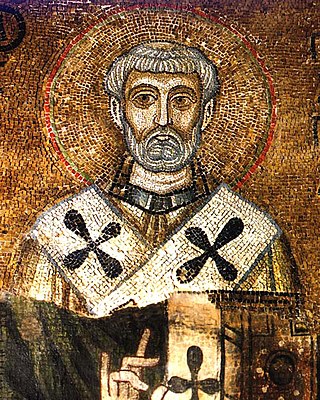
Pope Clement I was bishop of Rome in the late first century AD. He is listed by Irenaeus and Tertullian as the bishop of Rome, holding office from 88 AD to his death in 99 AD. He is considered to be the first Apostolic Father of the Church, one of the three chief ones together with Polycarp and Ignatius of Antioch.

The Third Council of Constantinople, counted as the Sixth Ecumenical Council by the Eastern Orthodox and Catholic Churches, as well as by certain other Western Churches, met in 680–681 and condemned monoenergism and monothelitism as heretical and defined Jesus Christ as having two energies and two wills.
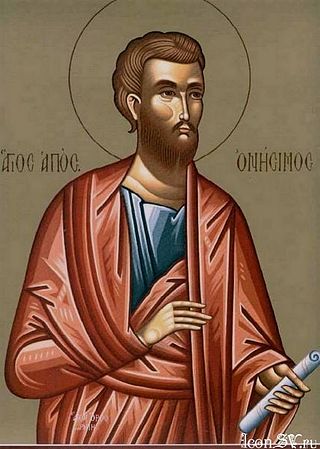
Onesimus, also called Onesimus of Byzantium and The Holy Apostle Onesimus in the Eastern Orthodox Church, was probably a slave to Philemon of Colossae, a man of Christian faith. He may also be the same Onesimus named by Ignatius of Antioch as bishop in Ephesus which would put Onesimus's death closer to 95. If so, Onesimus went from slave to brother to bishop.
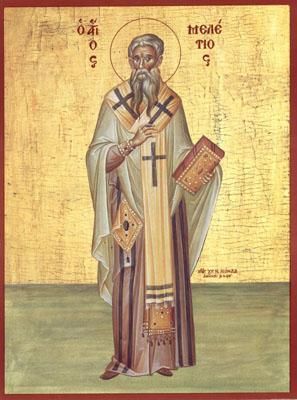
Saint Meletius was a Christian bishop of Antioch from 360 until his death in 381. He was opposed by a rival bishop named Paulinus and his episcopate was dominated by the schism, usually called the Meletian schism. As a result, he was exiled from Antioch in 361–362, 365–366 and 371–378. One of his last acts was to preside over the First Council of Constantinople in 381.
The Apostolic Fathers, also known as the Ante-Nicene Fathers, were core Christian theologians among the Church Fathers who lived in the 1st and 2nd centuries AD who are believed to have personally known some of the Twelve Apostles or to have been significantly influenced by them. Their writings, though widely circulated in early Christianity, were not included in the canon of the New Testament. Many of the writings derive from the same time period and geographical location as other works of early Christian literature which came to be part of the New Testament.
Gennadius of Massilia, also known as Gennadius Scholasticus or Gennadius Massiliensis, was a 5th-century Christian priest and historian.

Lucian of Antioch, known as Lucian the Martyr, was a Christian presbyter, theologian and martyr. He was noted for both his scholarship and ascetic piety.
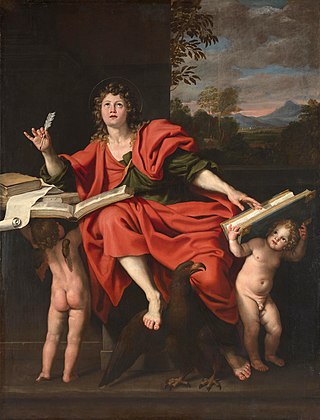
John the Presbyter was an obscure figure of the early Church who is either distinguished from or identified with the Apostle John and/or John of Patmos. He appears in fragments from the church father Papias of Hierapolis as one of the author's sources and is first unequivocally distinguished from the Apostle by Eusebius of Caesarea. He is frequently proposed by some as an alternative author of some or all of the Johannine books in the New Testament.

De Viris Illustribus is a collection of short biographies of 135 authors, written in Latin, by the 4th-century Latin Church Father Jerome. He completed this work at Bethlehem in 392–393 AD. The work consists of a prologue plus 135 chapters, each consisting of a brief biography. Jerome himself is the subject of the final chapter. A Greek version of the book, possibly by the same Sophronius who is the subject of Chapter 134, also survives. Many biographies take as their subject figures important in Christian Church history and pay especial attention to their careers as writers. It "was written as an apologetic work to prove that the Church had produced learned men." The book was dedicated to Flavius Lucius Dexter, who served as high chamberlain to Theodosius I and as praetorian prefect to Honorius. Dexter was the son of Saint Pacianus, who is eulogized in the work.
The Pneumatomachi, also known as Macedonians or Semi-Arians in Constantinople and the Tropici in Alexandria, were an anti-Nicene Creed sect which flourished in the regions adjacent to the Hellespont during the latter half of the fourth, and the beginning of the fifth centuries. They denied the godhood of the Holy Ghost, hence the Greek name Pneumatomachi or 'Combators against the Spirit'.
Theodotus, patriarch of Antioch, in AD 420 succeeded Alexander, under whom the long-standing schism at Antioch had been healed, and followed his lead in replacing the honoured name of Chrysostom on the diptychs of the church. He is described by Theodoret, at one time one of his presbyters, as "the pearl of temperance," "adorned with a splendid life and a knowledge of the divine dogmas". Joannes Moschus relates anecdotes illustrative of his meekness when treated rudely by his clergy, and his kindness on a journey in insisting on one of his presbyters exchanging his horse for the patriarch's litter. By his gentleness he brought back the Apollinarians to the church without rigidly insisting on their formal renouncement of their errors. On the real character of Pelagius's teaching becoming known in the East and the consequent withdrawal of the testimony previously given by the synods of Jerusalem and Caesarea to his orthodoxy, Theodotus presided at the final synod held at Antioch at which Pelagius was condemned and expelled from Jerusalem and the other holy sites, and he joined with Praylius of Jerusalem in the synodical letters to Rome, stating what had been done. The most probable date of this synod is that given by Hefele: A.D. 424. When in 424 Alexander, founder of the order of the Acoemetae, visited Antioch, Theodotus refused to receive him as being suspected of heretical views. His feeling was not shared by the Antiochenes, who, ever eager after novelty, deserted their own churches and crowded to listen to Alexander's fervid eloquence. Theodotus took part in the ordination of Sisinnius as patriarch of Constantinople, in February 426, and united in the synodical letter addressed by the bishops then assembled to the bishops of Pamphylia against the Massalian heresy. He died in 429.
The historical roots of Papal primacy can be traced back to the early centuries of Christianity, wherein the Bishop of Rome, commonly referred to as the Pope, gradually accrued increasing authority and recognition. A confluence of historical, theological, and political factors contributed to this development.

Saint Peter, also known as Peter the Apostle, Simon Peter, Simeon, Simon, or Cephas, was one of the Twelve Apostles of Jesus Christ and one of the first leaders of the early Christian Church. He appears repeatedly and prominently in all four New Testament gospels as well as the Acts of the Apostles.
The Eastern Orthodox Church is opposed to the Roman Catholic doctrine of papal supremacy. While not denying that primacy does exist for the Bishop of Rome, Eastern Orthodox Christians argue that the tradition of Rome's primacy in the early Church was not equivalent to the current doctrine of supremacy.

The Epistle of Ignatius to the Magnesians is an epistle attributed to Ignatius of Antioch, a second-century bishop of Antioch, and addressed to the church in Magnesia on the Maeander. It was written during Ignatius' transport from Antioch to his execution in Rome.

Papacy in early Christianity was the period in papal history between 30 A.D., when according to Catholic doctrine, St. Peter effectively assumed his pastoral role as the Visible Head of the Church, until the pontificate of St. Miltiades, in 313, when Peace in the Church began.